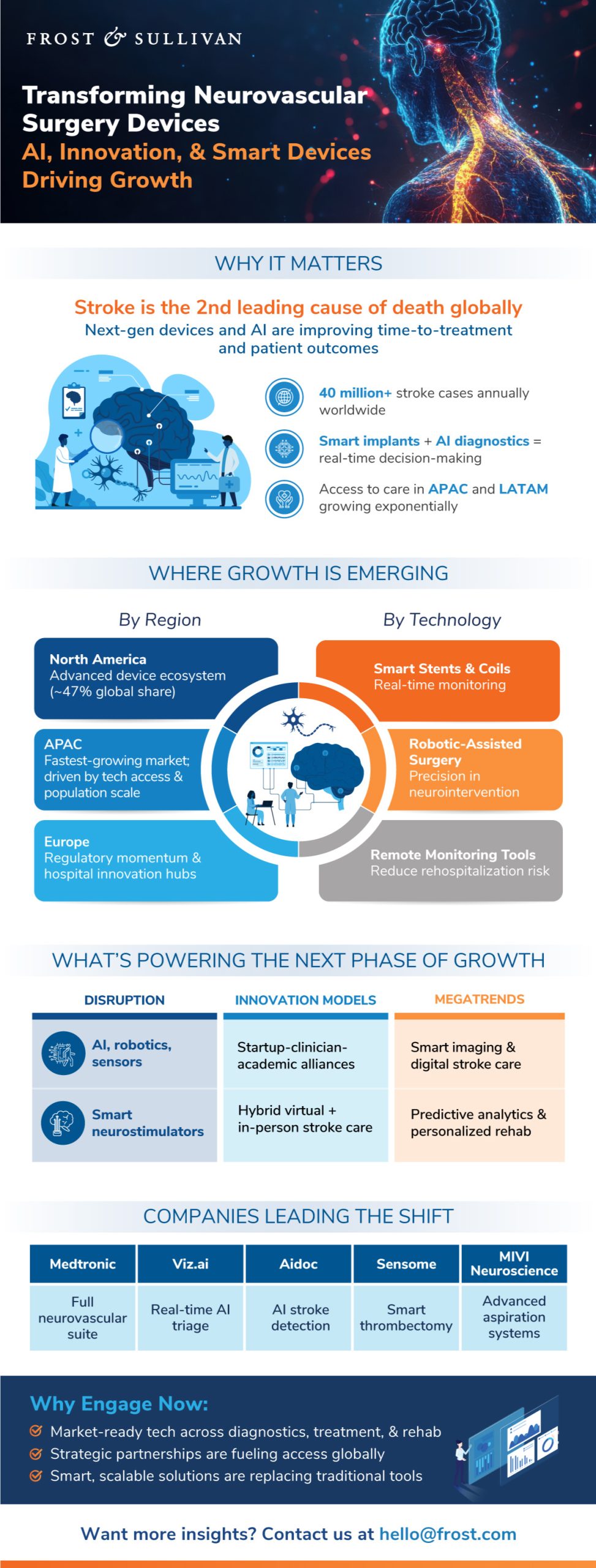For exclusive access and in-depth growth opportunities in neurovascular surgical devices, download our comprehensive analysis today!
The neurovascular surgical devices market is undergoing a dramatic transformation, driven by advances in artificial intelligence, minimally invasive procedures, and personalized medicine. As healthcare systems worldwide aim to improve outcomes in stroke and cerebrovascular disease management, this sector is poised for strong growth between 2025 and 2029.
The demand for faster diagnosis, safer procedures, and smarter devices is pushing the boundaries of what’s possible in neurointervention. From AI-driven imaging to remote stroke monitoring, the landscape is evolving rapidly — and with it, opportunities for both established players and disruptors.
Is your organization positioned to capitalize on the convergence of AI, data, and device innovation in neurovascular care — or will competitors lead the way?

Key Industry Drivers
The industry’s expansion is propelled by a confluence of technological, clinical, and economic factors:
- Shift to minimally invasive techniques such as thrombectomy and embolization
- Increased prevalence of strokes and aneurysms, particularly in aging populations
- Technological convergence with AI, robotics, and imaging tools
- Rising demand for real-time, remote monitoring post-surgery
- Supportive regulatory and reimbursement frameworks in key regions
How are your product pipelines and partnerships adapting to the demand for faster, minimally invasive, and data-rich neurovascular solutions?
Technology Innovations Leading the Way
New neurovascular devices are not just mechanical tools — they are becoming intelligent, adaptive solutions. A major leap forward is seen in devices embedded with sensors and capable of wireless data transmission.
Key breakthroughs include:
- Smart stents and coils: Provide real-time data on blood flow and pressure
- Remote monitoring tools: Help detect reocclusion or migration without frequent imaging
- AI-powered imaging platforms: Used for stroke detection, triage, and procedural planning
Two standout examples:
- Viz.ai – AI-based platform for real-time imaging and diagnosis, now in over 1,400 hospitals
- RapidAI – Deployed in 2,000+ hospitals across 100+ countries for stroke analysis
Regional Highlights and Growth Hotspots
North America
- Represents ~47% of the global market
- High adoption of thrombectomy and embolization devices
- Strong ecosystem of hospitals, payers, and device manufacturers
Asia-Pacific
- Fastest-growing region due to rising healthcare access and population density
- Japan leads in technology deployment; China and India are key emerging markets
- Strategic partnerships with local distributors are crucial for market penetration
Are your go-to-market strategies aligned with the unique regulatory, technological, and demographic dynamics of APAC and North America?
Strategic Imperatives Reshaping the Ecosystem
The future of neurovascular surgical devices is being shaped by three powerful strategic imperatives:
- Disruptive Technology
- Use of robotics, smart coils, and AI-driven workflows
- Need for advanced post-operative monitoring tools
- Innovations like sensor-embedded implants enabling real-time performance tracking
- Innovative Business Models
- Cross-collaboration between start-ups, academic labs, and clinicians
- Growth of telemedicine in stroke diagnostics and follow-ups
- Emergence of hybrid care platforms combining virtual and in-person care
- Transformative Megatrends
- AI-enhanced precision in detecting abnormalities and planning surgeries
- Decision support tools that reduce response time in emergency stroke care
- Integration of care platforms to bridge diagnostic and therapeutic gaps
Which of these imperatives is your organization prioritizing — and what internal barriers must be removed to execute faster?
Companies to Action: Disruptors and Leaders
| Company | Innovation Focus | Notable Solutions |
| Medtronic | Full neurovascular suite | Pipeline embolization device, Solitaire X, Onyx embolization system |
| Aidoc | AI-based diagnosis | aiOS platform for hemorrhage and aneurysm care |
| Sensome | Smart thrombectomy | Clotild guidewire with AI-based clot analysis |
| MIVI Neuroscience | Clot removal | Q and DAISe aspiration systems for enhanced success |
| Viz.ai | Real-time triage | AI-driven care coordination across multiple imaging formats |
Are you partnering with these disruptors — or preparing to compete against them?
Emerging Innovators in Neurovascular Surgery
The neurovascular surgical devices market is witnessing an exciting transformation thanks to disruptive technologies and emerging players that are reshaping treatment paradigms. Here are a few standout companies:
Growth Opportunities on the Horizon
The next phase of growth will rely heavily on enhancing patient outcomes not just during the procedure, but throughout the care journey.
Rehabilitation & Neurostimulation
- Post-stroke disability remains a major issue despite procedural success
- Devices such as:
- Transcranial Magnetic Stimulation (TMS)
- Vagus Nerve Stimulation (VNS)
- Deep Brain Stimulation (DBS)
- Market leaders like Boston Scientific and St. Jude are investing in neuromodulation to address unmet rehabilitation needs
Predictive Analytics & Preventive Devices
- Preventive tools like Boston Scientific’s Watchman FLX reduce reliance on blood thinners
- Predictive AI to identify high-risk patients (e.g., with atrial fibrillation) and recommend tailored interventions
How are you extending your value proposition beyond acute care into prevention and long-term recovery?
Challenges to Address
While growth is promising, companies will need to navigate several obstacles:
- High costs of advanced devices, especially in price-sensitive regions
- Lengthy regulatory approval cycles slowing innovation
- Infrastructure gaps in remote or underdeveloped regions
These challenges create space for cost-effective, scalable solutions that maintain clinical effectiveness while ensuring wider accessibility.
How can your innovation strategy balance cutting-edge performance with affordability and global accessibility?
The Next Chapter: A Smarter, More Personalized Era for Neurovascular Care
The neurovascular surgical devices market is poised to redefine standards in stroke management and cerebrovascular intervention. With:
- Intelligent devices improving outcomes
- AI enhancing diagnostic speed and accuracy
- Strategic collaborations fueling R&D and access
…the future of neurovascular care is not just innovative—it’s intelligent, accessible, and globally scalable.
What bold steps will your organization take today to lead in tomorrow’s neurovascular care ecosystem?
This blog is based on the recent analysis “Neurovascular Surgical Devices Industry, Global, 2025-2029”, authored by Dr. Bejoy Daniel, Senior Industry Analyst, Healthcare & Life Sciences Practice, Frost & Sullivan,
Want to dive deeper? Click here to connect with Dr. Bejoy Daniel and other growth experts In Healthcare & Life Sciences and discover how this analysis can help accelerate your growth strategy.




